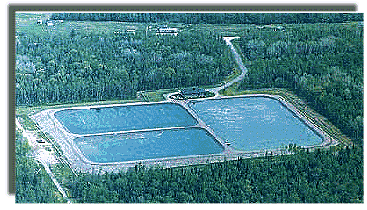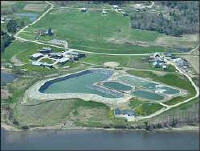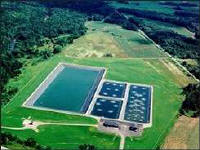|

Restoring the natural quality of our
rivers and streams has been a major task for municipalities and
industries. In Newport, Maine, the Sanitary District and
the town's major industry have worked closely together to address
a significant local problem. The Newport wastewater collection and
treatment facilities have eliminated untreated domestic and
industrial wastewater discharges and significantly improved the
quality of the East Branch of the Sebasticook River.
Prior to construction
of the new secondary treatment facilities, the East Branch of the
Sebasticook River was being contaminated by untreated wastewater
discharges from about half of Newport's 3,000 residents as well as
from the H.P. Hood cottage cheese plant. The river was not
suitable for fishing swimming and other recreational uses.
In 1980,
Wright-Pierce completed a facility plan which recommended an
aerated-facultative lagoon treatment system as the most
cost-effective way to provide secondary biological treatment for
the unique mixture of municipal and dairy wastes present in
Newport. The relatively remote site for the treatment
facilities was selected to provide suitable buffer zones from
residential development. The location also satisfied the public
concern that the plant be located outside of the drainage area of
Sebasticook Lake, which has been the subject of a state and
federal funded restoration program.
In order to proceed
with construction of the wastewater collection and treatment
facilities in the face of a limited construction grants program,
the project was constructed in five phases. In total, the five
contracts involved 14,000 feet of new sanitary sewers; 2,100 feet
of new storm drains; a cast-in-place pump station; 8,000 feet of
force main; a 29 million gallon, Hypalon lined 3-lagoon treatment
system; and a 3,100 square foot operations building.
The aerated
lagoon treatment system covers about 10 acres. Normally, this
would be considered quite large for a town the size of Newport,
but is required to treat the high strength waste from the cottage
cheese plant. Since adequate affordable land was available for the
construction of lagoons, Wright-Pierce was able to demonstrate the
cost-effectiveness of this type of facility in comparison to more
energy intensive traditional methods. As a result, the Newport
treatment plant represents a very cost-effective solution for H.P.
Hood and has very affordable user charges for the residential and
commercial customers.
The total
construction cost of the Newport wastewater collection and
treatment facilities was approximately $4.7million. State and
federal grants paid for 87.9% of the cost. The Sanitary District
and H.P. Hood paid 8.0% and 4.1% respectively. The Farmers Home
Administration is providing long-term financing of the District's
share of project costs. |

